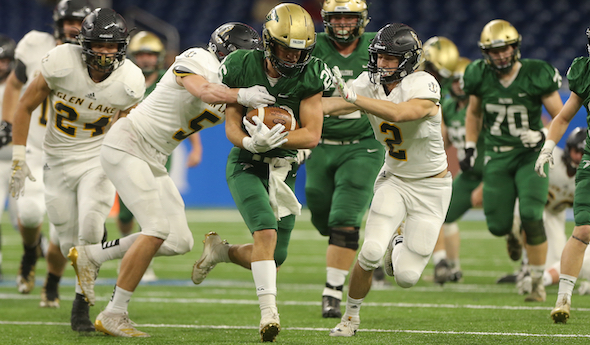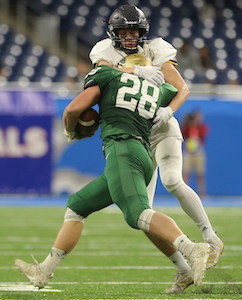
Monroe SMCC Wins Championship Grind
November 29, 2019
By Geoff Kimmerly
Second Half editor
DETROIT – If Monroe St. Mary Catholic Central could draw up the perfect game for its preferred style of play, it might look a lot like Friday’s Division 6 Final.
Yes, the Falcons defeated Maple City Glen Lake to win their first championship since 2014, so that makes it memorable no matter what. And sure, SMCC would’ve loved to score more – the offense averaged 34 points per game heading into the night.
But look past all of that and consider: The Falcons had 63 plays to Glen Lake’s 32, and ran the ball 58 times. They had 22 first downs to Glen Lake’s six. They had the ball nearly twice as long – 31:17 to 16:43 – and didn’t have one penalty called against them. And the defense posted its first shutout of the season.
Offensive efficiency and defensive prowess have been hallmarks of a program that was playing in its eighth MHSAA Final – and the victory was proof again that the workmanlike approach remains a viable a championship approach during an era dominated by wide-open and fast-paced attacks.
“It’s not really the score that we anticipated, but it’s OK – we’re a grinding team, we have faith in our defense and our offense to eat up time on the clock,” SMCC senior quarterback Wyatt Bergmoser said. “We just rep our plays, and if it does come down to the defense we let them do their thing and it’s not a big deal – we have trust in the other players on the field.
“We were on different teams (before high school) but we knew we’d come together and play together in the future, and that’s something we dreamed of and hoped for forever. As a kid, I went to the 2014 state championship game. I just remember sitting in the stands and thinking to myself, I want to be here one day. I want to be here with my friends, with my other players and grind it out and get a state championship for myself. And that’s what we did, and I love all my players and teammates for that.”
The Falcons finished 12-1, their only defeat this season 28-21 to Division 4 Milan in Week 3.
 That close loss, which eventually decided the Huron League title, provided a lesson that would serve St. Mary as it worked to finish off its mission for the ultimate playoff prize.
That close loss, which eventually decided the Huron League title, provided a lesson that would serve St. Mary as it worked to finish off its mission for the ultimate playoff prize.
SMCC led in the fourth quarter by a point, and punted on 4th-and-4 with just under seven minutes to play. Milan went ahead on the next possession, and the Falcons ran out of time.
On Friday, SMCC punted only twice and converted on four of five fourth-down tries, including two during a 14-play, 55-yard fourth-quarter possession that didn’t result in a score but did drain 7:48 off the clock. That possession also left Glen Lake to try to tie beginning at its own 7-yard line with 2:27 to play.
“Earlier in the year we were hitting some big runs, but three, four, five yards are great plays for our offense,” SMCC coach Adam Kipf said. “We don’t need to hit a home run. We don’t need to get 10 yards every time we touch it. But if we’re getting three yards a pop … 2½ yards, we’re in great position. We like to do that, and we’ll chew up 35, 36, 37 seconds on the play clock too, and that’s by design. We want to keep it out of their hands.”
The game’s lone score came on a Bergmoser six-yard touchdown run just under five minutes into the second quarter, which capped a 10-play, 94-yard drive lasting 5:22.
The Falcons ran for 249 yards total, led by senior Alex Morgan’s 123 on 22 carries. They held Glen Lake (12-2) to 127 yards total, 75 of it coming through the air on passes by senior quarterback Reece Hazelton. The Lakers got no deeper into SMCC territory than the 36-yard line.
“They were probably the biggest team we faced all year, since we’re pretty big ourselves,” Glen Lake junior receiver/defensive back Finn Hogan said. “It was a little different change of pace for us. It took a drive or two for us to get used to, and they capitalized.”
The seven points tied the fewest Glen Lake gave up in a game this season – seven times the Lakers gave up seven, and they allowed a solid 16.2 on average over the entire fall. Hogan and senior linebacker Jonathan Wright led Friday’s effort with 12 tackles apiece, and as a team Glen Lake had six tackles for loss.
Bergmoser also was his team’s high tackler with seven.
Glen Lake had last appeared in a Final in 2016, also finishing Division 6 runner-up that year. The Falcons, meanwhile, finished a rare 4-5 that fall, but came back with seven wins in 2017 and nine last season to set up this year’s run.
“Going into high school my freshman year, I knew we had a special group in our class. I think everyone knew we were special,” Morgan said. “My sophomore year we had 11 starters on the team that made the playoff run. Our junior year we had a ton of juniors starting on that team. So we had one goal in mind this senior year, and it was to be right where we are right now.”
PHOTOS: (Top) St. Mary’s Alex Morgan (26) is slowed by Glen Lake’s C.J. Helfrich (2) and Finn Hogan. (Middle) A Glen Lake defender works to bring down the Falcons’ Samuel Cousino.

NFHS Voice: Campaign Touts Benefits of High School Football
By
Karissa Niehoff
NFHS Executive Director
May 21, 2021
A full return to high school sports and performing arts programs – that’s the hope for this fall in schools across the country.
After a year of unprecedented challenges in keeping these programs going due to the pandemic, which included 11 states that conducted their primary football season this spring, there is great optimism as we look to a new school year.
Even in those states that were able to conduct activities last fall, attendance restrictions kept many fans out of stadiums and watching games online. However, with vaccine eligibility now at 12 years of age and older and with vaccinations continuing during the next three months, the likelihood of routines and traditions returning this fall grows stronger each day.
And there is no tradition more anticipated than the full-scale return of high school football. While there were 34 states there were fortunate enough to conduct football at some level last fall, the routines were anything but normal.
This fall, however, we anticipate a return to the energy and excitement of the 2019 season when 1,003,524 boys participated in 11-player football. That total marked a decline of only 2,489 from the previous year and was a good sign of a renewed confidence on the part of parents and student-athletes that concerns about the risk of injury were being addressed.
While boys participation in 11-player football has exceeded one million participants every year since 1999 and is overwhelmingly the most popular boys sport, there have been concerns about declines in past years.
Last fall, the NFHS and the National Football League announced a partnership to promote the growth, understanding and support for football at the high school level. The NFHS and NFL have been studying participation trends, developing educational tools and striving to restore confidence in students and parents that the sport is, in fact, more focused on risk minimization than ever before.
As a result, the springboard to the return of high school football next fall begins this week with the launch of the #ThisIsHSFootball campaign. Through this effort over the next few months, the NFHS will be reaching out to coaches, students, parents, officials, athletic directors and others with research information, participation trends and data on various risk mitigation efforts that, we believe, continues to make high school football safer than it has ever been.
As a part of this effort, the NFHS produced a video entitled “This is High School Football” designed to detail the benefits of participation in high school football.
As the video states, more so than at any other level of play, parents should feel good about their kids playing high school football.
>Here are some of the many educational and medical safeguards put in place the past 12 years to offer parents a comfort level about the safety standards that are a part of high school football.
► Concussion research and education. All NFHS high school playing rules require a student who is exhibiting signs of a concussion to be removed from the game and not allowed to return until the student has been cleared by a medical professional. Thanks to education and training on the part of students, coaches, trainers, parents and others, research data has shown positive trends in concussion rates. In a recent five-year period, concussion rates during practices dropped from 5.47 to 4.44 concussions per 10,000 athletic exposures.
► Concussion in Sport Course. This free online education course has been available through the NFHS Learning Center since 2010, and millions of individuals have taken the course for a deeper understanding about concussions.
► Concussion Laws. By 2014, every state had adopted state concussion laws that established mandatory protocols, and every state high school association has adopted policies that limit contact during preseason drills and in practices during the season.
► Football equipment. Manufacturers continue to produce higher quality equipment every year, and high school coaches are doing a much better job at teaching and coaching the rules of the game and making attempts to minimize risk of injury for players.
► Emergency Action Plans. Thanks to the NFHS Foundation, a copy of the “Anyone Can Save a Life” emergency action plan originally developed by the Minnesota State High School League was sent to all state high school associations and their high schools, and all schools have access to an AED to help save lives.
► Playing Rules. Risk minimization is a major focus of every NFHS sports rules committee. In football, helmet-to-helmet hits are not allowed.
High school football has been a significant part of schools, towns and communities across America for almost 100 years. The NFHS is committed to making the sport as safe as possible for the millions of kids who will play the sport in the years to come.
Dr. Karissa L. Niehoff is in her third year as executive director of the National Federation of State High School Associations (NFHS) in Indianapolis, Indiana. She is the first female to head the national leadership organization for high school athletics and performing arts activities and the sixth full-time executive director of the NFHS, which celebrated its 100th year of service during the 2018-19 school year. She previously was executive director of the Connecticut Association of Schools-Connecticut Interscholastic Athletic Conference for seven years.

